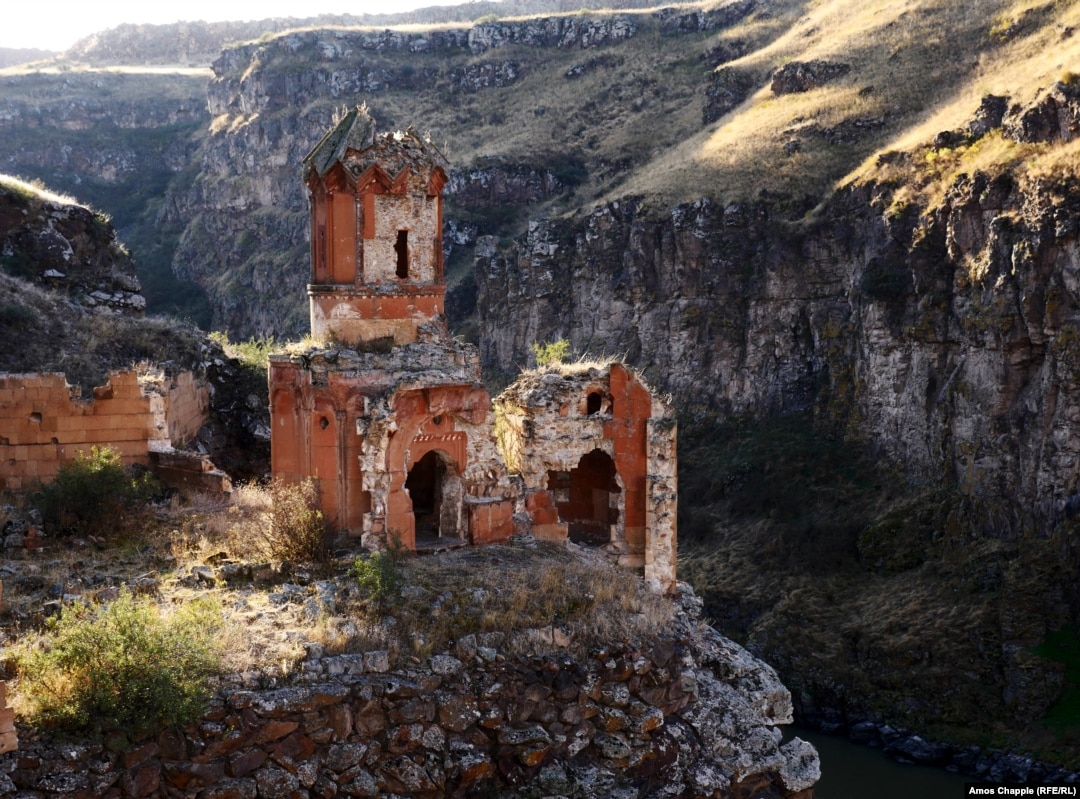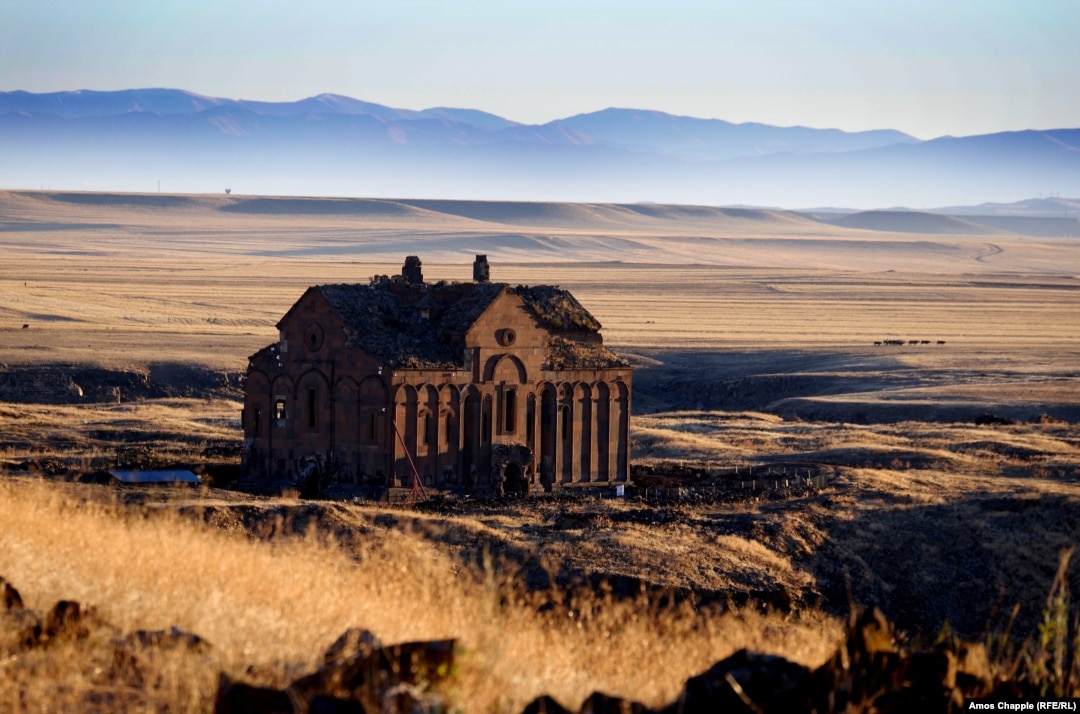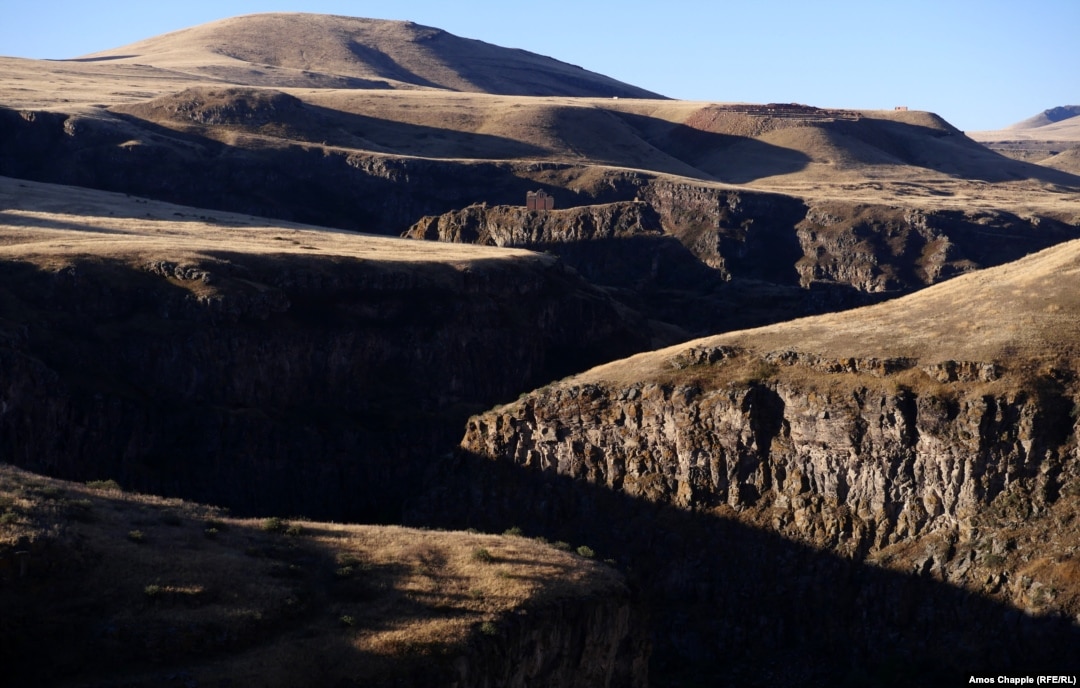Armenia's Broken Heritage

In a gorge that separates Armenia (background) from Turkey, the Monastery of the Hripsimian Virgins is one of the crumbling remnants of Ani, a capital once known as the "City Of 1,001 Churches."

Sun-scorched plains and the ruins of Ani Cathedral. A complex tug-of-war since its founding more than a millennium ago saw Ani variously controlled by Russia, the Ottoman Empire, and Armenia before finally being captured by the newly formed Turkish Republic in 1920. Ani was abandoned centuries ago, but it is treasured by Armenians today as a symbol of former splendor.

The Church of Saint Gregory of the Abughamrents in Ani. In 1998, three tombs inside the church were smashed and looted.

The ruins of Kizkale Church overlooking the jigsaw border that separates Armenia (left) and Turkey. In 1914, more than 2 million Armenians lived in today's eastern Turkey, then a part of the Ottoman Empire. By 1922, more than three-quarters of those Armenians had perished or fled a state-organized drive to eradicate Armenians from Ottoman territory.
Remnants of the Mausoleum of Child Princes in Ani. A little over a century ago, as the Ottoman Empire began to crumble, Armenians -- a Christian minority in a Muslim empire -- were viewed as a fifth column, sympathetic to their fellow Christians in the Russian empire.
An outdated sign declaring a portion of Ani a military zone. The Turkish side of the border is demilitarized, but some areas of Ani remain off limits.
The Canyon that separates Turkey and Armenia. In 1915, after Ottoman authorities issued an order calling for the "deportation" of the entire Armenian population, a frenzy of killing began across the region, which today lies in eastern Turkey.
Inside Ani after dark, the lights of an Armenian border post (right) glint behind the Church of St. Gregory of Tigran Honents. The Turkish-Armenian border has been closed since 1993, when Ankara also cut off diplomatic ties with Yerevan in connection with Armenia's dispute with Azerbaijan over the territory of Nagorno-Karabakh.
Inside the Church of St Gregory of Tigran Honents. Many of the frescoes inside have been literally defaced. The damage done to Ani may be at an end now that UNESCO has some jurisdiction over the ruins; but outside the UNESCO site, the Armenian heritage in Turkey is at the mercy of a state that seems eager to forget Armenians existed in the region at all.
Snow drifting down onto the Armenian side of the border, seen from just outside Ani. Although Ani has stood abandoned for centuries, the land around, like much of today's eastern Turkey, was populated by Armenian communities until the deportation order of 1915 and the ensuing mass killings. More than 1 million ethnic Armenians were killed in what Yerevan and many others regard as the 20th century's first genocide.
Kars, a bustling city one hour from Ani, was once around 85 percent Armenian. But today few locals purport to know anything about the "Armenian cemetery" that lies in ruins on a rocky hill above the city.
The site is dotted with stone tombstones, many lying face-down. Some of the ancient graves appear to have been dug up by what a local guide calls "treasure hunters."
In Kars, the house reported to be the former home of the revered Armenian poet Yeghishe Charents.
The Cathedral of Kars (bottom right) was the main place of worship for Armenians before 1915. In 1993, it was converted into a mosque.
A chapel that was once a part of Bagnair Monastery, in the village of Kozluca, a few kilometers outside Ani. Signs describing the Armenian structures in Ani, and the villages around, avoid using the word "Armenian."
A khachkar on the site of the now-ruined monastery in Kozluca. Khachkars are traditional, carved Armenian artworks that mark holy places.
Kizil Kilise church, in the village of Yagkesen. The village, a few kilometers outside Ani, was Armenian until 1920, when its Armenian inhabitants were forced to flee to Soviet Armenia.
The interior of Kizil Kilise church. The ancient structure is currently used to house chickens. The cross above the entrance to the church has been chipped away.
A living gargoyle, in the form of a Caucasian sheepdog, chained to the church.
On the plains around Ani, Mt. Ararat, the fabled landing place of Noah's Ark, looms above the landscape. Ararat features on the coat of arms of Armenia but today lies within Turkish borders.
Oğuzlu church, around 16 kilometers from Ani. The church was largely intact until 1936, when an earthquake reportedly destroyed the structure.
A local from the village of Oguzlu shows a khachkar that is being used as part of a fencepost. The men of the village say they found two khachkars when excavating the foundations of a house in the village.

